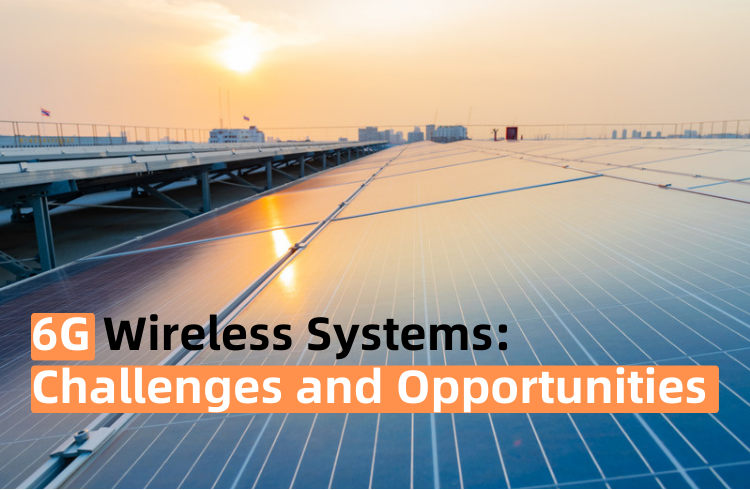
Introduction
Wireless communication has been an integral part of our daily lives, and it is rapidly evolving. Currently, the fifth generation (5G) wireless system is being rolled out worldwide, and researchers have already begun exploring the sixth generation (6G) wireless system. 6G is expected to be a significant step forward in wireless communication, with faster speeds, lower latency, and higher capacity. However, with the increased capabilities come new challenges that need to be addressed before the system can be deployed. In this article, we will discuss the challenges and opportunities presented by 6G wireless systems.
Technical challenges of 6G
· Higher frequencies
One of the primary challenges in designing 6G systems is the use of higher frequencies. The current 5G systems operate in the sub-6 GHz frequency range, while 6G is expected to operate at higher frequencies, such as millimeter-wave (mmWave) frequencies above 100 GHz. These higher frequencies offer several benefits, including increased capacity and reduced latency. However, they also present several challenges. For example, higher frequencies have shorter wavelengths, which means that signals are easily blocked by obstacles like buildings and trees. This requires the use of multiple antennas to provide better coverage, which increases the complexity of the system.
Another challenge with higher frequencies is the increased path loss. The path loss is the reduction in signal strength as the signal travels through the air. Higher frequencies have a higher path loss compared to lower frequencies, which means that the signal strength decreases rapidly over distance. This requires the use of more power to maintain a strong signal, which can lead to increased interference and reduced battery life.
· Antenna design
As mentioned earlier, 6G systems will require the use of multiple antennas to provide better coverage. This presents a challenge in designing the antennas, as they need to be small enough to fit into devices but still provide sufficient gain and directionality. Furthermore, the antennas need to be designed to operate at higher frequencies, which presents additional design challenges.
One potential solution is to use metamaterials to design antennas that can operate at higher frequencies. Metamaterials are artificial materials that have properties not found in nature, such as negative refractive index, which allows them to bend electromagnetic waves in unique ways. By using metamaterials, it may be possible to design antennas that are smaller and more efficient than traditional antennas.
· Power consumption
6G systems will likely require more power to operate than 5G systems due to the use of higher frequencies and multiple antennas. This presents a challenge in designing devices that can operate for extended periods without needing to be recharged. Furthermore, the increased power consumption can lead to increased interference and reduced battery life, which can impact the overall performance of the system.
One solution to this challenge is to use energy-efficient components and optimize the power consumption of the system. For example, 6G systems could use beamforming to direct signals only where they are needed, which can reduce the overall power consumption of the system.
· Security
As with any wireless system, security is a significant concern for 6G systems. The increased capacity and speed of 6G systems will likely make them more attractive targets for cyber attacks. Furthermore, the use of higher frequencies and multiple antennas can make it easier for attackers to intercept signals.
To address these concerns, 6G systems will need to incorporate robust security measures, such as encryption and authentication protocols. Furthermore, the system will need to be designed with security in mind from the ground up, with security features built into the hardware and software.
Opportunities presented by 6G
· Increased capacity
6G systems are expected to offer significantly increased capacity compared to 5G systems. This increased capacity will enable new applications and services that are not currently possible with 5G, such as high-quality virtual and augmented reality experiences, immersive gaming, and real-time remote collaboration. This increased capacity will also enable more devices to be connected simultaneously, which is essential for the Internet of Things (IoT).
· Lower latency
6G systems are also expected to have significantly lower latency than 5G systems. Latency refers to the time it takes for data to travel from the source to the destination. Lower latency is critical for applications that require real-time interaction, such as online gaming, virtual and augmented reality, and autonomous vehicles. With 6G systems, latency is expected to be as low as one millisecond, which is nearly instantaneous and will enable new levels of interactivity.
· Improved reliability
6G systems are expected to be more reliable than 5G systems. This is because 6G systems will likely use multiple antennas and beamforming techniques to direct signals only where they are needed, reducing interference and improving signal quality. This improved reliability will be essential for mission-critical applications, such as autonomous vehicles and healthcare.
· New applications and services
6G systems will enable new applications and services that are not currently possible with 5G systems. For example, 6G systems could enable seamless communication between humans and machines, such as brain-computer interfaces, which would have significant implications for healthcare and rehabilitation. Additionally, 6G systems could enable new levels of automation, such as in manufacturing and logistics.
Conclusion
In conclusion, 6G wireless systems present both challenges and opportunities. The use of higher frequencies, multiple antennas, and beamforming techniques will provide increased capacity, lower latency, and improved reliability, enabling new applications and services. However, these new capabilities also present challenges in terms of antenna design, power consumption, and security. Addressing these challenges will be critical in the successful deployment of 6G systems. Nonetheless, the potential benefits of 6G wireless systems are vast, and they have the potential to revolutionize wireless communication and transform industries worldwide.
Source: https://www.telecomtrainer.com/6g-wireless-systems-challenges-and-opportunities/

